This LP prototype, likely built by Gibson in 1958, is a fascinating piece of the iconic guitar style’s lineage.
In the pantheon of electric guitar legends, few names resonate as powerfully as Les Paul. Not only did he lend his name to one of the most iconic guitars of all time, but he was also a relentless innovator—forever tweaking, refining, and reshaping his tools to chase the elusive perfection of tone. While many collectors and musicians have been captivated by his namesake production models, few have laid eyes on, let alone held, one of the true instruments crafted explicitly for Les Paul himself. This is the story of one such guitar: a custom-built black flat-top Gibson that was part of a rare twin set—crafted to meet the singular standards of a musical genius.
Les Paul’s relationship with the electric guitar wasn’t one of casual use or simple preference. He was a pioneer, deeply immersed in the mechanics of tone and sustain. His work not only revolutionized how guitars were made, but also how they were recorded and performed with. This particular instrument, one of two black flat-tops likely built in 1958 alongside a pair of white counterparts, was a tool in his quest—a quest that combined science, artistry, and an insatiable curiosity.
At first glance, the guitar seems understated. The black finish and flat-top construction suggest minimalism. But closer inspection reveals a level of design and detail that goes far beyond standard factory output. The body—a .25” maple cap atop a solid mahogany core—eschews the arched top and neck binding that many associate with high-end Gibsons of the era. It’s a design born from utility: flatter for increased contact, perhaps for Les’ recording techniques; unbound for ease of modification.

The staple P-90, whammy, and hard-carved bridge on display.
But it’s inside the guitar where things get really interesting. Deep pickup cavities hint at experimentation beneath the surface. The control cavity was uniquely routed for access from both front and rear—an unusual feature likely intended to make electronics swaps and tests easier. The headstock, too, bears the mark of purposeful divergence: elongated with a long taper behind the nut, enhancing string length and tension, possibly for sustain or tonal balance.
And then there are the modifications—refinements so specific they could only come from someone who viewed the guitar not as a finished product, but as a laboratory for sonic discovery. The pickups, Gibson’s low-impedance alnico “staple” style, were either wound by Les himself or by his son Gene. These pickups, with double-tall bobbins and a unique 4-screw mounting system, required a transformer to step up the impedance for direct input to an amp. AIR coils, reverse-wound for hum-cancelling, were mounted beneath the pickguard, beside each pickup. According to Les’ close friend and tech Tom Doyle, Les was using this technique in the late 1940s to get a quieter signal.
“The spirit of the guitar—Les’ spirit—remained intact. It’s not a sterile museum piece, but a living, breathing testament to a life spent chasing sound.”
In terms of playability, Les took matters into his own hands—literally. The neck profile was hand-shaped and refinished in black acrylic. The frets? Low, flat, and re-crowned using nothing more than flat files and emery boards—crude by modern standards, but a testament to Les’ commitment to hands-on craftsmanship. And the bridge? Carved by Les himself from wood, anchored with hefty .25" studs to improve energy transfer and sustain.
Another particularly unique feature is the missing 22nd fret. Removed deliberately, it allowed Les to move the neck pickup further up the body, balancing volume and tone as he climbed the fretboard—a mod unheard of at the time, and one that permanently altered the original pickguard. In true Les fashion, he crafted a new one, hand-shaped and signed on the back. That signature alone would make this guitar historic. The story it tells elevates it to something close to mythic.
Beyond the customizations and features, the guitar bears the marks of its life. It’s a well-played instrument, worn from hours of rehearsal, performance, and experimentation. The original finish has held up remarkably well, with only minor touch-ups. The neck, however, wears its black paint like a badge of honor—proof of Les’ own hand at work. A headstock break in the mid-1960s forced its early retirement from Les’ regular use. Yet even in its dormancy, it remained significant.
In 1974, the guitar changed hands through a trade, eventually resting in the possession of its most recent owner, Les’ friend and sound man Geoff Gray. It sat in storage for decades until its restoration began in 1998. The headstock was professionally repaired, and components like tuners, pots, and Bigsby were replaced with period-correct parts wherever possible. Importantly, the spirit of the guitar—Les’ spirit—remained intact. It’s not a sterile museum piece, but a living, breathing testament to a life spent chasing sound.
This guitar, with its unique blend of factory precision and raw, personal modification, represents the closest one can get to stepping inside Les Paul’s creative process. It’s not just a player’s guitar. It’s not just a collector’s trophy. It’s a physical manifestation of innovation. A rare portal into the mind of a man who changed the course of music history.
Offered most recently by Carter Vintage Guitars in Nashville for a cool $950,000, the guitar has since been sold. But its story continues to echo—a tone that, like Les himself, refuses to fade.
SOURCES: Carter Vintage Guitar interview with Geoff Gray, personal letter from Tom Doyle, October 2024.








 Whether or not Jimi Hendrix actually played this guitar might come down to how lucky its buyer feels.Photo courtesy of Imperial Vintage Guitars Reverb Shop
Whether or not Jimi Hendrix actually played this guitar might come down to how lucky its buyer feels.Photo courtesy of Imperial Vintage Guitars Reverb Shop



![Rig Rundown: AFI [2025]](https://www.premierguitar.com/media-library/youtube.jpg?id=62064741&width=1245&height=700&quality=70&coordinates=0%2C0%2C0%2C0)








